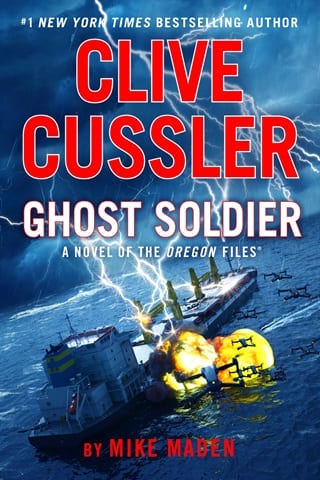Chapter 66
66
Today’s weather was problematic, as was the E-3 Sentry’s bumpy ride. Stallabrass enlisted in the Air Force because he wanted to be a fighter pilot, but he washed out of the program because of a disorienting inner ear imbalance he experienced during flight training. The Air Force brass frowned on its young pilots puking in their multimillion-dollar cockpits, but in its collective wisdom the Big Blue Machine had put him in the back of the Sentry. He had served with distinction, but often at the cost of a queasy stomach like he was currently experiencing. The cool cabin air that kept the computers from overheating was small comfort to his growing headache, exacerbated by the constant whine of the 707’s noisy turbines.
“Captain, take a look at this,” one of his techs said. Stallabrass stepped over to his monitor.
“Where the heck did those come from?”
“No idea. They just popped up. One hundred nineteen miles and closing. Fast movers. Not ours.”
Stallabrass studied the six radar images. Two were much stronger than the other four, but none of them were solid hits, and all were moving at Mach 1 or close to it in the storm.
Weather conditions might explain the weakness of the radar images. More likely, it was a combination of reduced radar cross section, radar absorbent materials, and possibly even radar jamming or deception.
In short, stealth aircraft.
That was bad. The Chinese were the only country in the world besides the United States and Russia producing fifth-generation stealth aircraft. Air Force intelligence reported several Chinese variants were already operational and new systems would soon come online. There was no way to tell at this point which ones were on his display. But what was certain was that all Chinese stealth planes carried anti-ship and anti-aircraft weapons that were now in striking range of Guam.
What didn’t make sense to him was the different sizes of the images.
“Who’s on patrol?”
“Major Joslin is the flight lead. McGhee is his wingman. They just acknowledged the radar hits.” The two F-35s were networked with the Sentry’s radar returns.
Stallabrass nodded. Joslin and McGhee were flying F-35s, America’s best fighter. More importantly, Joslin was a highly decorated and experienced combat pilot. He couldn’t think of another pair of zoomies he’d rather have in the air.
“Vector them to that location. High priority.”
“Yes, sir.”
★Major Joslin—call sign “Hawkeye” for his twenty-ten vision—studied his display, fed with Stallabrass’s E-3 radar data. The tangos were moving at Mach 9 at fifty feet above the deck. Gutsy. He’d seen rogue waves reach higher than that.
He was irritated his own radar hadn’t picked them up first. He needed to buy Stallabrass a beer for the heads-up when they got back to the O club.
Joslin’s F-35 was capable of targeting and destroying all six aircraft at this distance and they were still closing at over twelve hundred feet per second.
Chances were, the Chinese were having a hard time getting radar returns in this weather as well. They might not even know he and McGhee were getting up in their grill.
By his calculation, in just under five minutes he wouldn’t have to fire any missiles. He could reach out with his foot and trip the Chicoms as they zoomed past.
He keyed his mic and told his wingman that he was dropping down. He’d meet them head-on at fifty feet.
Suddenly, his alarms sounded. The Chinese had radar lock on him.
“Hawkeye, I’ve been lit up,” McGhee said. “Permission to lock.”
“Permission granted, War Lord.”
★Lieutenant Commander Xu studied the two F-35s on his helmet-mounted display system, the same kind of device that provided American pilots three-hundred-sixty-degree views around their aircraft.
So far, the Americans had responded exactly as expected and now that he and Gao had initiated radar lock, the Americans would soon respond in kind.
His team wouldn’t give them that opportunity.
“Initiate,” Xu ordered over his secured comms.
The two backseat weapons officers took charge.
★Just as Joslin was about to confirm his six targets, four of the tangos peeled off—and disappeared.
What happened?
Joslin thought his systems had glitched. He keyed his mic.
“Wizard, this is Hawkeye. I’ve lost four contacts.”
Stallabrass responded. “Same on our end. The tangos must have some new electronic countermeasures.”
“I still show two on my radar. Locking now.” He tapped his touchscreen display, arming two long-range AIM-120 missiles and selecting his two targets. McGhee did the same.
“Will keep you advised, Hawkeye.” Stallabrass keyed off.
Joslin and McGhee rode the rail for another thirty seconds, seeing what the Chinese planes might be up to.
Stallabrass crackled on his comms.
“Hawkeye, this is Wizard. Base reports anti-radiation seekers have been activated, source unknown.”
What were these cowboys doing?Not only were he and McGhee in the crosshairs, but so were the radar sites on the island. The first strike in an attack is always aimed at air defenses. This was definitely a hostile move.
“Hawkeye, heads-up,” Stallabrass said. “Anti-ship missile signatures have now been detected. All tangos are now considered hostiles.”
Joslin fought the urge to swear. Until now, the Chinese hadn’t targeted ships. These guys were getting serious.
The question was, How serious?
A couple of rogue pilots out to make a name for themselves could be looking for a gunfight. And right now, that’s what it felt like.
But it could be just another test to reveal American defensive tactics in preparation for an actual war.
Joslin’s eyes scanned his helmet display. They were closing in on the Chinese jets at a combined speed of Mach 1.8. Their AIM-120s were still locked on their targets, and the Chinese jets still had them targeted. A Mexican standoff at supersonic speed.
Time was running out.
Joslin’s brain made calculations his advanced avionics suite could not. The longer he waited to fire, the more he put McGhee and everyone else on the island at risk.
But if he pulled the trigger, he just might start World War III.
If the Chicoms really were hostile, why hadn’t they fired? That was easy. The closer they got, the better the odds of hitting their targets. Every moment that passed made death and destruction all the more likely.
And where were those other four tangos?
Joslin checked his digital clock. Two minutes until they reached the Chinese targets.
“Permission to fire?” McGhee asked.
The Chinese planes’ aggression was bold—and beyond the pale. But they were still on the other side of the Red Line—the twelve-mile limit surrounding the island. It was illegal for Joslin to fire at them until they crossed it.
But the Chicoms didn’t respect international law. They might fire first and accuse the Americans of starting it. And the closer they got, the more likely they were to doing just that.
“Don’t fire unless fired upon,” Joslin finally said. Those were the rules of engagement his commanders had imposed upon the flight.
“Roger that.”
Joslin checked his HUD display.
One minute and closing.
Joslin now had a visual of the two Chinese jets. He angled his fighter directly into the path of the Chicom flight lead.
“Boss?”
“Let’s see how much sand he’s got in his sack,” Joslin said. He settled into his seat.
“Hawkeye, you’re on a collision course,” Stallabrass said in his ear.
“That’s the general idea.”
“You’ve got a pair, Hawkeye. Large-caliber ones, and brass.”
“Thirty seconds to collision,” Stallabrass said.
The Chinese wingman entered a steep climb.
“I’m on him,” McGhee said as his plane clawed into the storming sky, giving chase.
Now it was just Joslin and the Chicom lead, head-to-head, in an old-fashioned showdown—at over thirteen hundred miles per hour.
Joslin switched on his short-range Sidewinders and locked them onto the Chinese fighter. The Chengdu J-20’s distinctive twin tail and angled fuselage were clearly displayed in the gloom. Its twin-seater frameless canopy made it one of the aircraft carrier variants. It was a cross between an F-35 and an F-22, America’s two best fighters. Rumor was the Chinese government had stolen the plans for both.
Joslin stole a glance at McGhee and his tango on the display. They rolled and spun like Olympic ice-skaters seven thousand feet above—and climbing.
Joslin slipped his finger over the trigger that would loose two missiles at his opponent.
Ten seconds.
Joslin began a mental countdown. He wasn’t going to flinch.
“I’m your huckleberry,” Joslin whispered to the Chinese jet.
Five, four, three, two…
Suddenly, his missile warning alarms snapped off. The Chinese jet had disengaged.
The Chengdu pilot rotated his bird ninety degrees on its axis, canopy inward.
Joslin matched him with a jerk of his joystick.
Their heads sped past each other just feet apart at a collective thirteen hundred miles per hour. He saw the blur of masked helmets glancing up in his direction.
Joslin rolled his plane back to horizontal, the airframe rocked by the Mighty Dragon’s waking air turbulence.
Suddenly, the four missing tangos appeared on his radar. They were heading away from Guam, their mission complete.
And there was no question that mission was to gather invaluable data on American radar locations, wavelengths, and capabilities. Data that could be used to wipe those installations out next time.
“Hawkeye,” Wizard said, “all six tangos are assuming a heading of three hundred eighteen degrees. Advise you follow.”
“Wilco,” Joslin said. “You catch that, War Lord?”
His wingman was already making his turn.
“On it.”
“Disengaging missile lock.” Joslin punched the toggles on his touchscreen.
“Disengaged,” McGhee reported.
Joslin eased the stick up. His tango had climbed to five thousand feet, pairing up with his wingman. Joslin and McGhee matched them.
Minutes later, the four pilotless drones pulled into position with the manned Chinese aircraft.
“You seeing this?” McGhee asked.
“Yup.” Joslin wasn’t completely surprised. He’d been a test pilot for the Air Force’s “Loyal Wingman” project that also paired AF pilots to drone aircraft. The American program had stalled. Obviously, the Chinese one had not.
Drone aircraft gave incredible advantages. Cheaper, faster, more maneuverable, and expendable, they could maximize speed, turns, and payloads, and if necessary, sacrifice themselves to accomplish the mission or protect human pilots.
They chased the Chinese flight for a hundred miles at a respectful distance. Joslin was grateful the Chinese men had chosen the better part of valor. Did the Chicom pilot chicken out? Or had he broken Joslin’s encrypted comms? Either way, he knew Joslin wouldn’t back down. That was all that mattered.
“Hawkeye and War Lord, you are requested to return to base for a debrief.”
“Roger that,” Joslin said. He was happy to return to base. It had been a long morning. He felt his energy drain away along with his adrenaline surge. A cup of coffee sounded pretty good, even if he was going to get chewed out by the Old Man.
Joslin was pleased with his performance. McGhee’s, too. They had shown the Chinese forces that while America might be in decline, her pilots were not.
But those pilots had taught them a lesson, too. They had shown courage, creativity, and technological advance. The next time, their drones could be used to confuse, swarm, and overwhelm. They had ushered in a new era of aerial warfare.
In the sweep of history, Joslin and McGhee would be remembered as the first Americans to confront drone fighters in a combat situation.
Unfortunately, they were on the wrong side of the broom.
If the Chinese tangos returned tomorrow, Joslin and his flight would be waiting for them. But in forty-eight hours, so would Guam’s new air defense system.
The Chinese wouldn’t stand a chance, no matter how many drones they brought.
 Fullepub
Fullepub 



